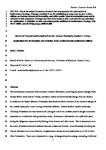Record of Cenozoic sedimentation from the Amanos Mountains, Southern Turkey: Implications for the inception and evolution of the Arabia–Eurasia continental collision
Date
2009-04Author
Subject
Metadata
Show full item recordAbstract
The sedimentary succession of the southern Amanos Mountains, bordering the eastern margin of the Karasu Rift in south central Turkey, provides a record of environmental change from the Eocene (Lutetian) to the Upper Miocene (Tortonian) that charts the final evolution of the northern margin of the Arabian plate prior to and during continental collision. Eocene shallow-marine carbonates (Haci{dotless}daǧi{dotless} Formation) are interpreted as the youngest unit of the Arabian passive margin succession deposited on a northwards facing carbonate ramp. Subsequent deformation and uplift took place during the Oligocene represented by folding of the Eocene and older strata. This is interpreted to be the result of initial continental collision between Arabia and Eurasia. Unconformably overlying the Eocene limestone are Lower Miocene conglomerates, sandstones and palaeosols up to 150 m thick (Ki{dotless}ci{dotless} Formation). These were deposited in a range of marginal marine settings consisting of alluvial fan/fan delta facies, flood plain as well as basinal facies. Subsequently, during the Middle Miocene, local patch reefs developed in restricted areas (Kepez Formation) followed by Upper Miocene sediments (Gökdere Formation) composed of relatively deep water hemipelagic marl, with clastic interbeds, which represent a transgression during this period. The Upper Miocene becomes sandier upwards, this records the regression from the relatively deep water facies to coastal sediments. Water depth gradually became shallower until during Pliocene time the area became continental in nature. By the Quaternary rifting had resulted in the development of the Karasu Rift with active alluvial fans along the margins and braided rivers depositing coarse conglomerates in the axial zone. These conglomerates are interbedded with basaltic lava flows that resulted from the region extension across the area. This research shows that initial continental collision occurred in this area after the Lutetian (40.4 Ma) and before the Aquitanian (23.03 Ma) supporting the hypothesis that the southern Neotethys Ocean closed during the Late Eocene to Oligocene. This was a time of climatic change including the onset of southern hemisphere glaciation, in which the closure of the southern Neotethys may have had played an important role. © 2009 Elsevier B.V. All rights reserved.
Publisher
Journal
Volume
Issue
Pagination
Recommended, similar items
The following license files are associated with this item:


